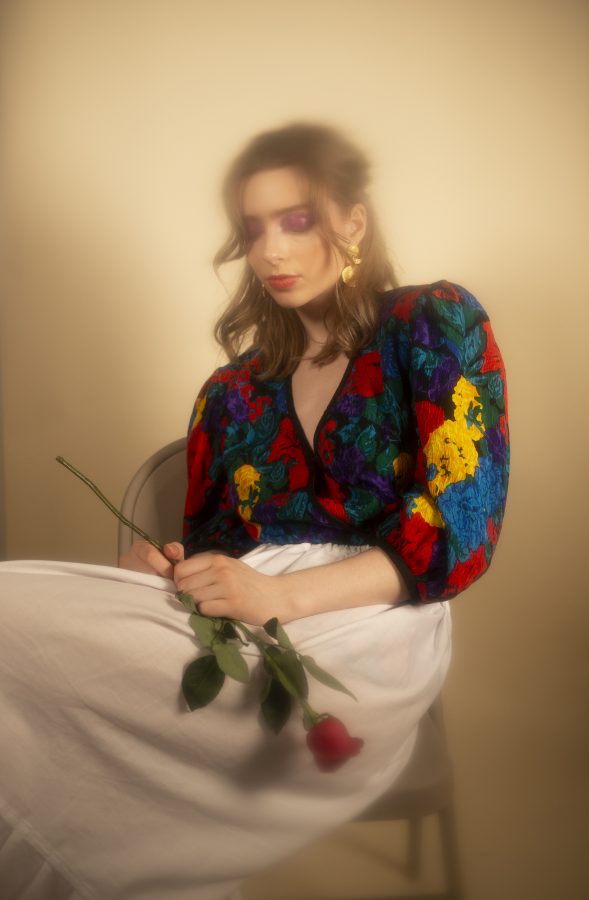The mere thought of low-rise jeans now elicits a cringe from all the proponents of the re-popularized high-waisted mom jean movement. Flo Rida’s favorite pair of 2000s “Reeboks with the straps” have been tossed into a black garbage bag, along with your mom’s 2006 copy of “Eat, Pray, Love,” destined for Goodwill.
An ’80s cultural revival has sent modern fashion trends reeling in reverse and has brought the dust-filled back of your closet back in vogue. As a result, the streets are a time capsule of ’80s fashion, with outfits torn directly from the pages of an outdated issue of Seventeen magazine and pasted onto the body of every stylish twentysomething.
CAS sophomore Niharika Chandrasekar, a social media coordinator for NYU.FASHION, is embracing this revival with a newfound appreciation for funky prints, neon and matching eyeliner.
“I do some really colorful looks that reflect on ’80s and ’90s fashion,” Chandrasekar said. “I have this crazy colorful leather jacket with shoulder pads that tends to be my favorite.”
Just a quick scroll through Chandresekar’s Instagram showcases her eclectic yet reminiscent style — in one photo, she sports leopard-print biker shorts, a Versace-esque jaguar shirt and chunky white sneakers.
Chandresekar’s Adidas Originals Falcons are a new staple in her closet, a product of the notorious ugly sneaker trend. While this trend stirred up quite the controversy in the fashion world, it is undeniably a nod to the ’80s and ’90s. FILA Disruptor II’s — proportionally challenged and chunky to the point of captivation — dominate the shoe wall at Urban Outfitters and Triple S Balenciagas — the original ugly sneakers — don the feet of fashionable elitists.
Social and Cultural Analysis Assistant Professor Sharon Heijin Lee says her staple shoes are also reminiscent of the ’90s, but slightly less clunky.
“A few years ago, I found my high school pair of Docs in my parents’ garage — over 20 years old and worn, but in perfect condition,” Lee said. After realizing that the ’90s grunge boots had made a comeback, she “happily reincorporated” the trademark yellow-stitched Dr. Martens into her wardrobe.
The resurgence of Dr. Martens didn’t come as a surprise to Lee, seeing as other shoes such as Birkenstocks had also crept their way back in the fashion zeitgeist a few years prior. Rather, it was the return of the high-waisted mom jeans that confounded her.
“I was too young to realize how cyclical fashion is when my peers and I recycled ‘70s fashions in the ’90s,” Lee said. “But now I’ve seen that cycle repeat a few times, so I can truly say every style will make a comeback eventually.”
For Gen Z-ers, it’s difficult to imagine a time when high-waisted jeans were as big a fashion crime as now-obsolete low-rise jeans. But Costume Studies Masters Program Director Nancy Deihl can’t believe high-waisted pants are back.
While attending a university-sponsored dinner, Deihl sat next to a man who she said was about her age.
“I said [to him] ‘so what do you think about the girls wearing the high-waisted jeans?’” Deihl recounted. “And he just put his head in his hands and said, ‘Isn’t it terrible?’”
However, Deihl also notes that this is not the first time fashion has borrowed from the past.
“This idea that fashion kind of looks back is not anything new,” Deihl said. “There was this whole 1950s revival when I was young. Stuff comes and goes.”
This pattern has long been established. Designers have looked toward trends from the past for inspiration since the 19th century, when European dresses were modeled after the wide skirt and cinched waist silhouette of the 18th century, largely defined by Marie Antoinette. In the 1980s, when the number of women in the workforce surged, there was a return of wide-shouldered power suits inspired by the wartime utility look of the 1940s.
According to Newsweek, the fashion trend cycle lifetime has gotten shorter — brands are reincorporating past trends within 20 years of their popularity, as opposed to the previous 30-year cycle.
Lee similarly recalls a resurgence in bell bottoms and repurposed vintage fashion — an obvious recycled trend from the ’70s — during her college years in the late ’90s that greatly influenced the culture of her own generation.
“I remember having a sense of curiosity about the ’70s and earlier, even romanticizing it,” Lee said. “The ’80s were too recent and seemed outdated yet, reaching back just a decade or more beyond that felt like we were reviving something special but in our own way. I’m reminded of this when I see my students wearing ’90s fashion today — it’s the same but with a contemporary twist.”
Similar to Lee’s generation, today’s youth seem to be romanticizing the ’80s and ’90s, watching trademark ’90s shows like “Friends” and buying vintage fashion.
Vintage styles have attracted swarms of young people seeking to channel their inner Macklemore and pop some tags at their local thrift shops. As a result, resale stores are thriving, soaking up money from the pockets of teens and college students desperate to transport themselves into a generation before their time. According to a study by ThredUp, a resale company, millennials and Gen Z-ers are driving the growth of the secondhand clothing industry. It predicts that within 10 years secondhand is expected to be bigger than fast fashion.
“A lot of my clothes are thrifted,” LS first-year Breana Sena said. “So it’s new to me, old to someone else. It’s sort of what I love about fashion. We repeat the past and pay respect to it, but at the same time, the millennials put their own spin on things to make it fresh and new again.”
Today, leggings, a 2010s athleisure trend, are matched with ’90s colorblock windbreakers. High-waisted skinny jeans are a hybrid of ’80s high-rise mom jeans and ’90s low-rise skinny jeans. Like Lee and Diehl in their college days, students are now piecing the past into more recent trends, which has resulted in quirky outfit combinations and a style unique to their generation.
“The recycling of fashion works on two registers — it invokes nostalgia for those that lived through it before and feels vintage for those who are experiencing it for the first time,” Lee said. “In this way, it’s the perfect marketing strategy.”
Don’t believe those who say fashion has gone stagnant. It’s this process of creating and borrowing that allows fashion to evolve.
Fashion is an assemblage of self-appropriation. It steals silhouettes and fabric combinations from itself and transforms over time, motivated by the battle between conformity and distinction. The result is the creation of new fashion and new trends, representative of individuality and creativity. And so the cycle continues.
Email Arin Garland at [email protected]. Read more from Washington Square News’ “Fringe: One Last Dance.”

























































































































































